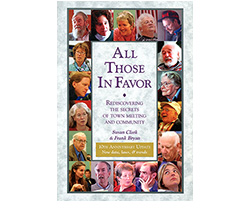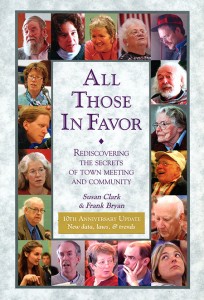
 copyright the Chronicle March 11, 2015
copyright the Chronicle March 11, 2015
All Those In Favor, Rediscovering the Secrets of Town Meeting and Community, by Susan Clark and Frank Bryan. Paperback. 87 pages. Published by Ravenmark, Montpelier, Vermont.
Reviewed by Tena Starr
Frank Bryan is likely Vermont’s staunchest champion of Town Meeting. He studied it for 30 years, and in this book, a tenth-anniversary update of the 2005 original, he and co-author Susan Clark add analysis of another 12 years.
Their research indicates that Town Meeting is in some trouble — no surprise — but they’re by no means announcing its demise. Instead, they suggest a number of ways to shoot a bit of adrenalin into Vermont’s system of direct democracy.
Primarily, they are opposed to moving toward Australian ballot, which they argue, is, indeed, a death sentence for Town Meetings. And they provide evidence that fiddling with the time, or the day, does not necessarily increase attendance. In many cases, moving from a Tuesday daytime meeting to a weekend or evening meeting has decreased participation because, as the authors point out, while many people don’t want to lose a workday to attend Town Meeting, even more don’t want to give up leisure time.
The primary reasons for decreased attendance are the size of a town and the issues on the Warning, the authors say. The bigger a town gets, the smaller the percentage of attendance. And if a Town Meeting Warning has little of consequence on it — few issues that affect or captivate voters — they’re more likely to stay away.
“While it is doubtful that there was ever a golden era of Town Meeting when nearly everyone turned out every year, attendance was much higher in the early days than today,” the book says. “Even well into the twentieth century it was much higher than it is now. Given the difficulties of life (from hugely longer workdays and work weeks, to much poorer transportation systems, to remarkably greater potential for sickness and poor health generally) one is struck by how complete Town Meeting democracy was in the past.
“Those who believe that people are much busier today than they were in the past (and that includes most commentators on modern life) have an incomplete understanding of history. What we really mean when we say we are busier today is that we have different priorities.
“Consider the little town of Craftsbury in the Northeast Kingdom as it was in 1840. So difficult was transportation over and through its rocky hillsides, it took 12 separate school districts to educate the children. The majority of the people farmed. They kept 333 horses, 1,718 cattle, 3,166 sheep, and 658 swine. They produced 47,906 pounds of potatoes and 14,398 bushels of oats along with 5,705 bushels of other crops, 3,171 tons of hay and 35,412 pounds of sugar. Meanwhile, they ran two gristmills, a hulling mill, two carding machine operations, ten sawmills, two fulling mills, three carriage makers, and one oil mill.
“Fewer than 1,200 women, men, and children accomplished all this. If you’ve ever worked on a small farm, or in the woods, you know that these people not only worked hard, they worked smart. Their lives were fully as complex and demanding, perhaps even more complex and demanding as ours today.
“If they can do it, we can do it, too.”
The Northeast Kingdom isn’t much plagued by the biggest hindrance to Town Meeting attendance — population. Only Newport and St. Johnsbury are big enough to reach the tipping point where attendance, or lack of, can be attributed to size, according to the authors’ formula.
But Town Meeting is affected everywhere by loss of local control. Issues, and whether voters have control over them or not, are at the heart of attendance in small towns, the authors assert. And Vermonters have had increasingly little say in much of what matters to them most.
For instance, under the current school funding system, cutting a local school budget does not necessarily translate into a tax decrease.
“The most reliable predictor of Town Meeting attendance, besides population size, is what’s on the Warning,” the book says. “Examples abound, but let’s visit one meeting in the Northeast Kingdom town of Holland after a particularly bad winter had deteriorated the town’s roads. Imagine this meeting’s discussion about whether to switch from an appointed road commissioner to an elected one. Combine this discussion with the fact that a challenger was running against a key select board member on this issue. The result: The attendance normally predicted for a town this size was exceeded by 100 percent.”
This book goes so far as to say that an item should be included on the Warning each year specifically to grab people’s attention. It suggests something like an item saying alcohol be banned within town limits. While that’s a bit of a stretch, the point is made.
Town Meetings are important not just because they give people a chance to practice hands-on governance, but also because of the community they provide, the authors say. And in neither case does moving toward Australian ballot help, they argue.
“In a well intentioned effort to include more people in decision making, an increasing number of Vermont towns are destroying their town meetings in the process.
“The Australian ballot is quick, easy, private, unaccountable, and most important, simple. It is also deadly.
“In a way, the Australian ballot is worse than deadly because it doesn’t kill Town Meeting quickly. And the execution is dishonest. We are told it will save Town Meeting, while the reality is that it poisons it and lets it die slowly….
“It leaves a town with neither a legislature nor a Town Meeting. In doing so it compromises the actions of the select board or school board, which must anticipate how the community will react to an issue and then submit this best guess to a winner-take-all decision.”
Also, the authors say, flexibility is forfeited because the ability to make amendments is lost. School boards may watch an entire budget go down because a compromise on one issue isn’t possible. Projects that could have been saved with a bit of tinkering are rejected because tinkering wasn’t an option.
“Using the Australian ballot instead of a Town Meeting is like creating an ice sculpture by taking one great swing at a block of ice with a sledgehammer instead of carefully applying a chisel with care over time,” the book says.
And informational meetings don’t fill the void because Vermonters don’t just want to talk about things, they want to do something about them, the authors say.
“The golden key to participation is to give citizens real power and real decisions to make,” the book says.
“Unlike the polling booth, Town Meetings can be exciting, interesting, and fun. They bring politics to life. Here laughter is often heard. Here we meet neighbors we haven’t seen for ages. Here we learn that Bill Stone over on the North Road is having trouble in mud season, too. Here we discover that the town library is offering a new program for our kids. Here, most of all, we get to see ourselves in the full light of real democracy.”
To improve Town Meeting, the authors suggest the following:
Highlight the issues. Select boards should creatively publicize certain items so people are aware of what’s happening. Develop a relationship with the local newspaper editor, they say, and ask for help getting the word out about major issues.
Arrange for childcare. “Happily one of the most important methods proven to increase Town Meeting attendance is also relatively simple: provide childcare during the meeting. Statistics show that this can improve attendance measurably, especially among women.” Generally, a local organization such as the Girl Scouts or the parent teacher association provides the childcare and benefits from any donations parents might like to offer.
If possible, skip microphones since they increase people’s anxiety about speaking in public.
Eat. The best-attended Town Meetings include food.
Build the agenda carefully. If a meeting drags on, people will leave, particularly after a meal, so if the most important items are voted on at the end of the meeting, fewer people will vote.
Include elements of celebration.
Susan Clark is a community facilitator and Frank Bryan is a University of Vermont political science professor emeritus.
The book is available at local bookstores or from www.vtinstituteforgovt.org for $9.95 plus $2.50 for shipping. To inquire about municipal or nonprofit pricing, or bulk orders, contact the Vermont Institute for Government at (802) 223-5824, or [email protected].
contact Tena Starr at [email protected]
For more free articles from the Chronicle like this one, see our Reviews pages. For all the Chronicle’s stories, subscribe:
Print subscription
Annual online subscription
Short-term online subscription







